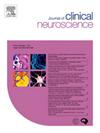深度学习辅助显著提高神经外科住院医师对蛛网膜下腔出血颅内动脉瘤的敏感度。
IF 1.9
4区 医学
Q3 CLINICAL NEUROLOGY
引用次数: 0
摘要
研究目的本研究旨在评估深度学习模型(DLM)在提高神经外科住院医师在动脉瘤性蛛网膜下腔出血(aSAH)患者的 CT 血管造影(CTA)中检测颅内动脉瘤的灵敏度方面的有效性:在这项诊断准确性研究中,三位神经外科盲人住院医师(一年级、三年级和五年级住院医师)共接受了104例蛛网膜下腔出血患者的CTA扫描,其中包含126个动脉瘤。初次阅读后,住院医师们得到了先前为自动检测和分割颅内动脉瘤而建立的专用 DLM 的预测结果。结果比较了 DLM 和住院医师在 DLM 协助下和没有 DLM 协助下对动脉瘤的检测灵敏度:结果:DLM 的检测灵敏度为 85.7%,而住院医师在没有 DLM 辅助的情况下,检测灵敏度分别为 77.8%、86.5% 和 87.3%。在获得 DLM 的结果后,居民的个人检测灵敏度分别提高到 97.6%、95.2% 和 98.4%,平均提高了 13.2%。DLM 对检测小动脉瘤特别有用。此外,住院医师之间的判读一致性从无 DLM 辅助时的 0.394 Fleiss κ 提高到有 DLM 辅助时的 0.703:这项试点研究的结果表明,深度学习模型可以帮助神经外科医生在 CTA 上检测动脉瘤,并在无法立即进行放射会诊时做出适当的治疗决定。本文章由计算机程序翻译,如有差异,请以英文原文为准。
Deep learning-assistance significantly increases the detection sensitivity of neurosurgery residents for intracranial aneurysms in subarachnoid hemorrhage
Objective
The purpose of this study was to evaluate the effectiveness of a deep learning model (DLM) in improving the sensitivity of neurosurgery residents to detect intracranial aneurysms on CT angiography (CTA) in patients with aneurysmal subarachnoid hemorrhage (aSAH).
Methods
In this diagnostic accuracy study, a set of 104 CTA scans of aSAH patients containing a total of 126 aneurysms were presented to three blinded neurosurgery residents (a first-year, third-year, and fifth-year resident), who individually assessed them for aneurysms. After the initial reading, the residents were given the predictions of a dedicated DLM previously established for automated detection and segmentation of intracranial aneurysms. The detection sensitivities for aneurysms of the DLM and the residents with and without the assistance of the DLM were compared.
Results
The DLM had a detection sensitivity of 85.7%, while the residents showed detection sensitivities of 77.8%, 86.5%, and 87.3% without DLM assistance. After being provided with the DLM’s results, the residents’ individual detection sensitivities increased to 97.6%, 95.2%, and 98.4%, respectively, yielding an average increase of 13.2%. The DLM was particularly useful in detecting small aneurysms. In addition, interrater agreement among residents increased from a Fleiss κ of 0.394 without DLM assistance to 0.703 with DLM assistance.
Conclusions
The results of this pilot study suggest that deep learning models can help neurosurgeons detect aneurysms on CTA and make appropriate treatment decisions when immediate radiological consultation is not possible.
求助全文
通过发布文献求助,成功后即可免费获取论文全文。
去求助
来源期刊

Journal of Clinical Neuroscience
医学-临床神经学
CiteScore
4.50
自引率
0.00%
发文量
402
审稿时长
40 days
期刊介绍:
This International journal, Journal of Clinical Neuroscience, publishes articles on clinical neurosurgery and neurology and the related neurosciences such as neuro-pathology, neuro-radiology, neuro-ophthalmology and neuro-physiology.
The journal has a broad International perspective, and emphasises the advances occurring in Asia, the Pacific Rim region, Europe and North America. The Journal acts as a focus for publication of major clinical and laboratory research, as well as publishing solicited manuscripts on specific subjects from experts, case reports and other information of interest to clinicians working in the clinical neurosciences.
 求助内容:
求助内容: 应助结果提醒方式:
应助结果提醒方式:


